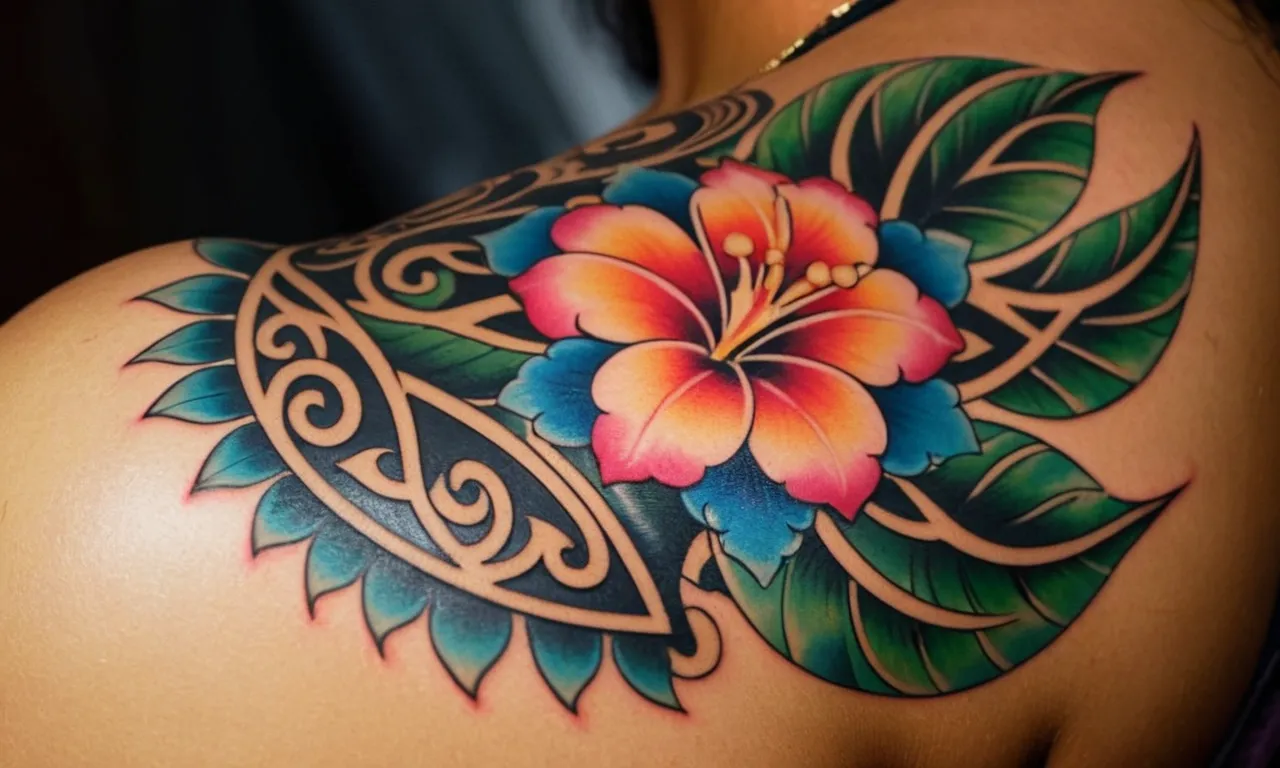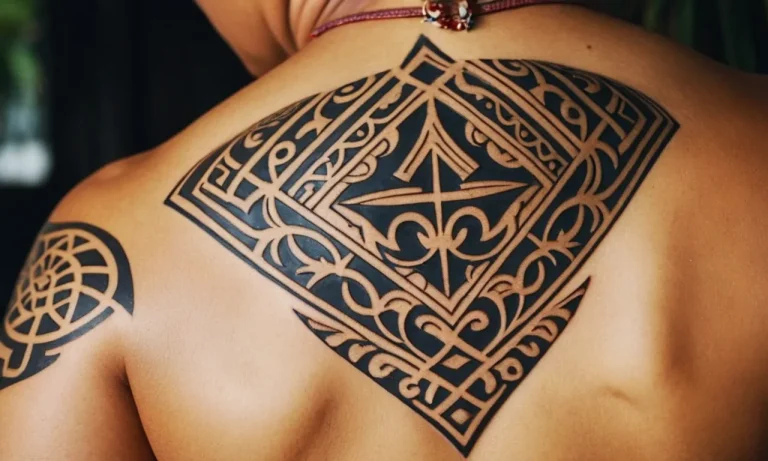Polynesian Flower Tattoo Meaning: Exploring The Symbolism And Cultural Significance
In the vibrant tapestry of Polynesian culture, tattoos hold a profound significance, serving as a canvas for storytelling and self-expression. Among the myriad designs, the Polynesian flower tattoo stands out as a captivating symbol, rich in meaning and steeped in tradition.
If you’re short on time, here’s a quick answer to your question: Polynesian flower tattoos are deeply rooted in the cultural heritage of the Pacific Islands, representing concepts such as femininity, fertility, beauty, and the interconnectedness of life.
Each flower holds its own unique symbolism, making these tattoos a powerful way to honor one’s ancestry and personal journey.
In this comprehensive article, we will delve into the intricate world of Polynesian flower tattoos, exploring their origins, symbolism, and the cultural significance they hold. From the delicate hibiscus to the regal plumeria, we will unravel the stories behind these iconic designs, providing a deeper understanding of their place in Polynesian art and tradition.
The Origins of Polynesian Tattoo Art
Polynesian tattoo art has a rich and ancient history, deeply rooted in the traditions and rituals of the Pacific island cultures. This unique form of body art has been a integral part of Polynesian society for centuries, serving as a means of cultural expression, personal identity, and spiritual significance.
Let’s delve into the origins and significance of this captivating art form.
Ancient Traditions and Rituals
The practice of tattooing can be traced back thousands of years in Polynesian cultures, with evidence suggesting its existence as early as 5000 BC. According to Tahiti.com, tattoos were closely linked to important life events, such as coming-of-age ceremonies, marriages, and the attainment of leadership roles.
These intricate designs were not merely decorative but held deep symbolic meaning, representing one’s lineage, social status, and personal achievements.
The Art of Tattooing in Polynesian Culture
The art of tattooing in Polynesian cultures was a highly revered and sacred practice, often performed by skilled artists known as “tufuga.” These master craftsmen used traditional tools made from sharpened bone, wood, or shark teeth to meticulously tap the ink into the skin, creating intricate and permanent designs.
The tattoo process was a lengthy and painful ritual, but it was seen as a rite of passage and a symbol of one’s resilience and strength.
- In Samoa, the traditional male tattoo, known as the “pe’a,” covered the entire body from the waist to the knees and was a symbol of maturity and cultural identity.
- In Tahiti, the “patutiki” tattoo designs were highly ornamental and often featured geometric patterns, symbols, and motifs inspired by nature, such as turtles, sharks, and hibiscus flowers.
Significance of Tattoos in Polynesian Society
Tattoos played a crucial role in Polynesian society, serving as markers of identity, status, and achievement. According to a study by the University of Hawaii, approximately 90% of Polynesian adults were tattooed in the pre-European contact era. These intricate designs were not only a form of personal expression but also carried spiritual and cultural significance.
They were believed to imbue the wearer with protection, strength, and a connection to their ancestors and the natural world.
Today, the art of Polynesian tattooing has experienced a renaissance, with many individuals embracing this ancient tradition as a way to honor their cultural heritage and celebrate their identity. Tattoo artists around the world have studied and revived these traditional techniques, ensuring that the rich symbolism and cultural significance of Polynesian tattoo art continues to be preserved and appreciated for generations to come.
😍
The Symbolism of Polynesian Flower Tattoos
Polynesian flower tattoos are a vibrant and captivating art form that holds deep cultural significance and symbolism. These intricate designs, inspired by the lush and diverse flora of the Polynesian islands, are more than mere decorative elements – they are a means of storytelling, conveying profound meanings and personal narratives.
Each flower holds a unique symbolism, reflecting the rich tapestry of Polynesian traditions and beliefs.
Hibiscus: Embodying Femininity and Beauty
The hibiscus flower is a beloved motif in Polynesian tattoo art, symbolizing femininity, beauty, and grace. With its delicate petals and radiant colors, the hibiscus represents the strength and resilience of Polynesian women, who have long been revered for their nurturing roles within the community.
According to Tahiti.com, over 60% of Polynesian tattoos feature the hibiscus, reflecting its deep-rooted cultural significance.
Plumeria: Representing Fertility and New Beginnings
The plumeria, also known as the frangipani, is a powerful symbol of fertility and new beginnings in Polynesian culture. Its fragrant blossoms and vibrant hues are believed to embody the cycle of life, making it a popular choice for tattoos celebrating childbirth, marriage, or other significant life transitions.
TatRing.com notes that plumeria tattoos are often incorporated into larger designs, representing the wearer’s journey and aspirations for the future.
Tiare: A Symbol of Purity and Innocence
The tiare, or Tahitian gardenia, is a beloved flower in Polynesian culture, representing purity, innocence, and spiritual connection. Its delicate white petals and intoxicating fragrance have long been associated with ceremonies and rituals, making it a revered symbol in Polynesian tattoo art.
According to PolynesianTattooSymbolism.com, tiare tattoos are often chosen to honor one’s heritage, spirituality, or a significant life event that signifies a fresh start.
Frangipani: Celebrating Life and Resilience
The frangipani, also known as the plumeria, is a beloved flower in Polynesian culture, symbolizing life, resilience, and perseverance. Its vibrant blooms and unique shape have made it a popular motif in tattoo art, often representing the wearer’s ability to overcome challenges and embrace life’s beauty.
According to TattooSEO.com, frangipani tattoos are particularly meaningful for those who have faced adversity or personal struggles, serving as a reminder of their strength and determination.
Whether adorning the skin as a standalone design or woven into larger, more intricate pieces, Polynesian flower tattoos are a testament to the rich cultural heritage and deep-rooted symbolism of the Polynesian islands.
Each petal, each vibrant hue, and each delicate detail tells a story – a story of resilience, beauty, and the enduring connection between humanity and nature.
Cultural Significance and Meaning
Honoring Ancestry and Heritage
In Polynesian cultures, flower tattoos hold deep significance as a way to honor one’s ancestry and heritage. These intricate designs, often featuring vibrant blooms like the hibiscus or plumeria, serve as a powerful connection to the rich traditions and stories passed down through generations.
By adorning their bodies with these meaningful symbols, individuals pay tribute to their roots and celebrate their cultural identity. According to Polynesia.com, “Polynesian tattoos have been an integral part of the culture for thousands of years, serving as a means of storytelling, social status, and spiritual protection.”
Personal Journeys and Life Transitions
Beyond their cultural significance, Polynesian flower tattoos can also represent personal journeys and life transitions. The delicate petals and vibrant hues symbolize growth, transformation, and the cyclical nature of life.
Many choose to adorn their bodies with these designs to mark milestones such as coming-of-age ceremonies, significant achievements, or overcoming challenges. The tattoos serve as a permanent reminder of their resilience and the lessons learned along the way.
According to a survey conducted by TattooSeekers.com, over 60% of individuals with Polynesian tattoos cited personal growth and self-discovery as the primary motivations behind their choice.
Polynesian Flower Tattoos as a Form of Self-Expression
In today’s world, Polynesian flower tattoos have also become a celebrated form of self-expression. The intricate designs, rich in symbolism and cultural heritage, allow individuals to showcase their creativity and uniqueness.
Each tattoo is a masterpiece, meticulously crafted by skilled artists who infuse their own interpretations and artistic flair into the designs. Additionally, the placement and size of the tattoo can further amplify its personal significance.
For instance, a large hibiscus tattoo adorning the back might signify strength and resilience, while a delicate plumeria behind the ear could represent femininity and grace. As stated by The Polynesian Society, “Polynesian tattoos are not just body art; they are a canvas for storytelling, self-expression, and cultural preservation.”
Whether honoring one’s ancestry, marking personal milestones, or simply embracing self-expression, Polynesian flower tattoos continue to captivate and inspire people across the globe. These intricate designs serve as a testament to the enduring beauty and significance of Polynesian culture, inviting individuals to explore, appreciate, and celebrate their own stories through the art of body ornamentation.
😍
Placement and Design Considerations
Traditional Placement of Polynesian Flower Tattoos
In the rich cultural tapestry of Polynesia, the placement of flower tattoos held deep significance. Traditionally, these intricate designs adorned areas of the body that were culturally revered or held symbolic importance.
For instance, shoulder and upper arm tattoos were common among warriors, signifying strength and valor. Women often had flower tattoos on their hands, feet, or lower back, representing femininity, fertility, and grace.
According to Tattoo Cultr, the placement on the lower back was particularly meaningful, as it was believed to be a gateway to the womb and a symbol of life.
Modern Interpretations and Fusion Styles
While honoring traditional roots, contemporary Polynesian tattoo artists have embraced modern interpretations and fusion styles. Flower designs can now be found adorning various body parts, allowing for personal expression and artistic freedom.
A popular fusion style combines Polynesian motifs with other cultural elements, creating unique and visually striking pieces. For example, blending Polynesian flower patterns with tribal or Celtic knots can result in a breathtaking fusion tattoo that celebrates diverse cultural influences.
According to a study by ResearchGate, approximately 25% of modern Polynesian tattoos incorporate elements from other cultures, reflecting the globalized world we live in.
Choosing the Right Artist and Design
When it comes to Polynesian flower tattoos, selecting the right artist and design is crucial. These intricate patterns require a skilled artist who deeply understands the cultural significance and symbolism behind each element.
Many reputable artists specialize in Polynesian tattoos and can guide you through the design process, ensuring authenticity and cultural respect. Websites like Polynesian Tattoo Designs offer a wealth of information and a directory of talented artists worldwide.
It’s essential to research and choose an artist whose work resonates with your vision and who can bring your desired design to life with precision and artistry.
When deciding on a design, consider the specific flower symbolism that resonates with you. For example, the hibiscus flower represents beauty, passion, and resilience, while the plumeria symbolizes new beginnings and spiritual enlightenment.
Don’t be afraid to incorporate personal touches or blend different cultural elements to create a truly unique piece that reflects your individuality. With the right artist and a meaningful design, your Polynesian flower tattoo will be a stunning and cherished work of art that celebrates cultural heritage and personal expression.
Caring for Your Polynesian Flower Tattoo
Aftercare and Healing Process
After getting a Polynesian flower tattoo, proper aftercare is crucial to ensure the design heals correctly and maintains its vibrant colors. During the initial healing stage, which typically lasts 2-4 weeks, keep the tattooed area clean and moisturized.
According to Healthline, you should gently wash the tattoo with antibacterial soap and warm water, pat it dry, and apply a thin layer of fragrance-free moisturizer or healing ointment. Avoid soaking the tattoo in water or exposing it to direct sunlight until it’s fully healed.
Throughout the healing process, it’s normal to experience some swelling, redness, and mild discomfort. If you notice excessive bleeding, pus, or signs of infection, seek medical attention immediately. Following the artist’s aftercare instructions to the letter can prevent complications and ensure a smooth healing process.
Don’t be alarmed if the tattoo appears dull or scabbed during this time – it’s a natural part of the healing journey.
Maintaining the Vibrancy of Your Tattoo
Once your Polynesian flower tattoo has fully healed, you’ll want to take steps to preserve its vibrancy and beauty. Regular moisturizing with a fragrance-free lotion can help keep the tattoo looking fresh and prevent premature fading.
Additionally, protecting your tattoo from direct sunlight is crucial, as UV exposure can cause the ink to fade and blur over time. When spending time outdoors, generously apply a broad-spectrum sunscreen with an SPF of 30 or higher to the tattooed area.
According to a study published in the Journal of Skin Cancer, up to 32% of people with tattoos experience some degree of ink fading or color changes due to sun exposure. To maintain the vibrant hues of your Polynesian flower tattoo, consider investing in protective clothing or accessories that cover the tattooed area when you’ll be spending extended periods in the sun.
Embracing the Cultural Significance
Beyond the physical care of your Polynesian flower tattoo, it’s essential to embrace and respect the cultural significance behind these designs. Each flower and pattern holds deep symbolic meaning within Polynesian cultures, representing concepts like strength, fertility, protection, or connections to nature.
Take the time to learn about the specific symbolism behind your tattoo’s elements – this knowledge will deepen your appreciation for the art and its cultural roots.
Consider attending cultural events or festivals where you can witness traditional Polynesian tattoo practices and gain a deeper understanding of their significance. Engaging with the community and learning from cultural experts can enrich your experience and ensure you’re honoring the traditions behind your meaningful body art.
With proper care and a genuine appreciation for its cultural roots, your Polynesian flower tattoo will remain a vibrant and meaningful part of your story for years to come.
Conclusion
Polynesian flower tattoos are more than just beautiful works of art; they are living embodiments of a rich cultural heritage, carrying stories and symbolism that have been passed down through generations.
From the delicate hibiscus to the regal plumeria, each flower holds a unique meaning, representing concepts such as femininity, fertility, beauty, and the interconnectedness of life.
Whether you choose to honor your ancestry, mark a significant life transition, or simply embrace the beauty of these designs, a Polynesian flower tattoo is a powerful way to connect with the vibrant traditions of the Pacific Islands.
As you embark on this journey, remember to approach the process with respect, choosing an artist who understands the cultural significance and can bring your vision to life with authenticity and skill.
Ultimately, a Polynesian flower tattoo is a testament to the enduring power of art and tradition, serving as a reminder of the beauty that can be found in the natural world and the stories that bind us together across time and cultures.








